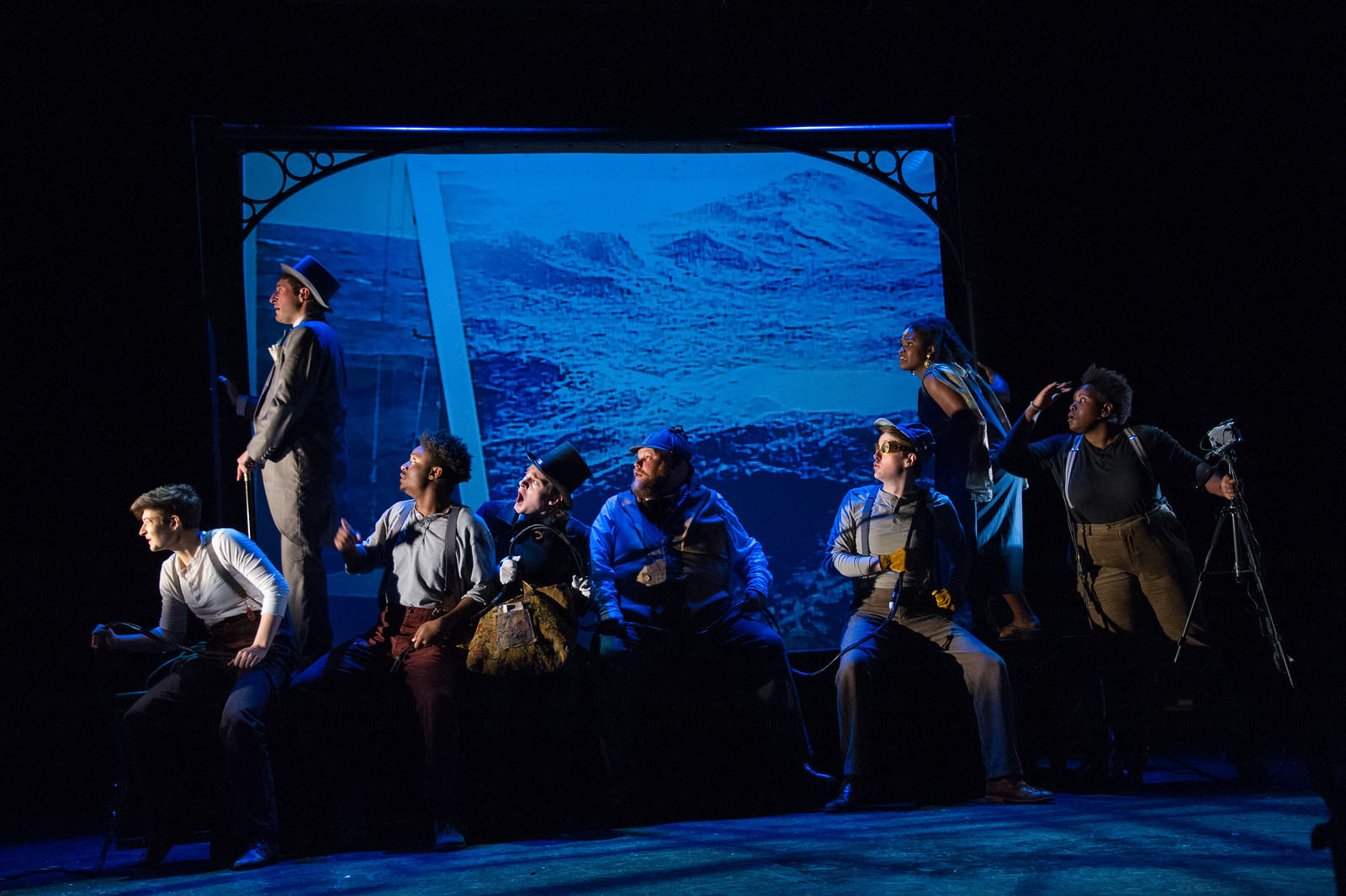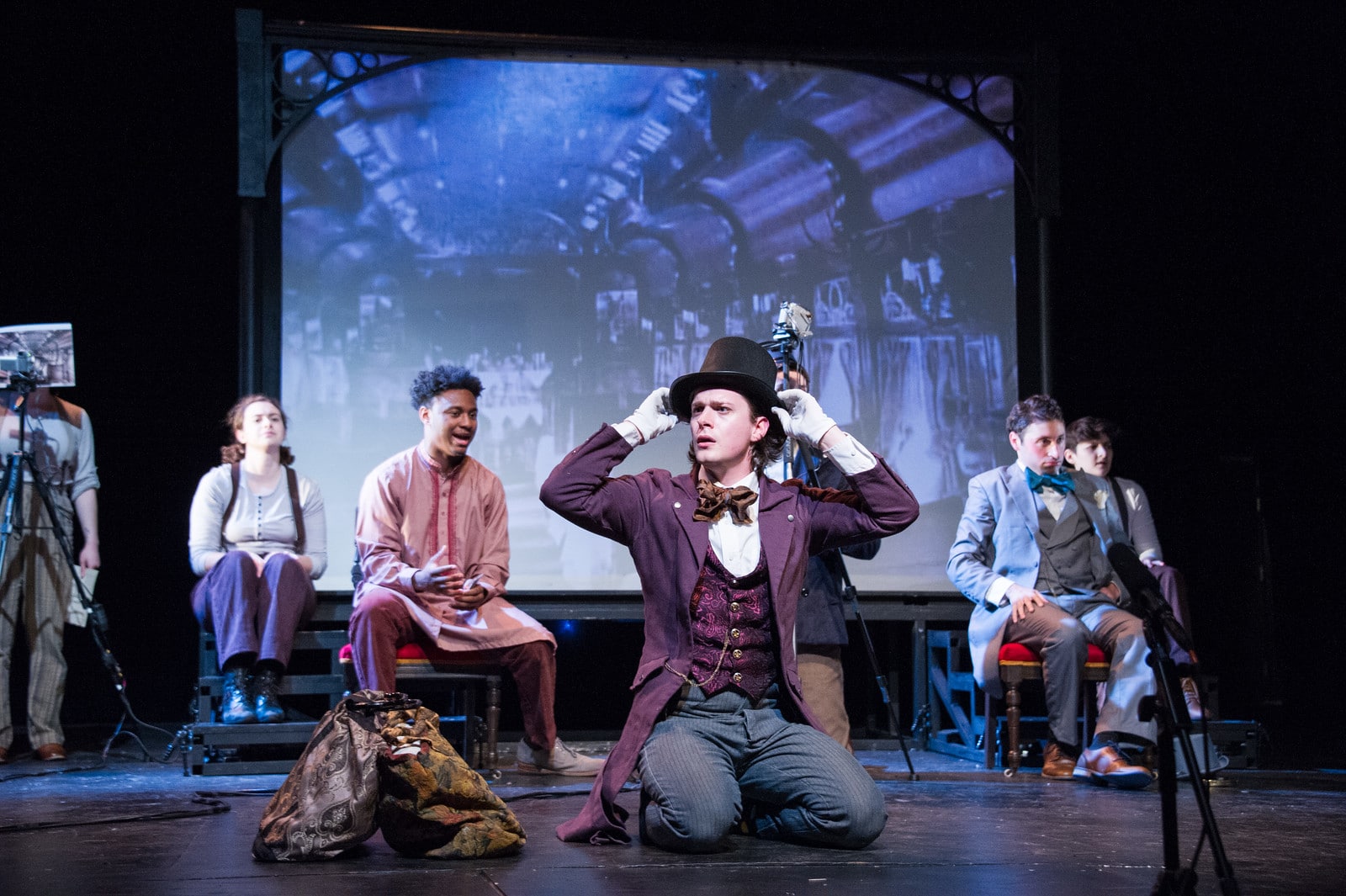It seems particularly appropriate that the National Players should be mounting a production about an imperturbable, peripatetic gambler who takes every mishap in stride while journeying as far as it is possible to go. As the touring outreach program of the Olney Theatre Center, these 10 young professional actors are flinging themselves into 10 months of traveling around the United States.

Embarking on its 70th Season, America’s longest-running touring company is bringing a three-play repertory of Shakespeare and other classic works not just to performing arts centers and universities, but also out-of-the-way schools, rural community centers, correctional facilities and other places where live theater is rare. The scrappy derring-do, unflappability, and keep-calm-and-carry-on attitude of Jules Verne’s hero Phileas Fogg (as adapted by Laura Eason) is an excellent metaphor for what the National Players do.
Directed by Jared Mezzocchi, the production has an amusing made-up-as-you-go feel (although it is clearly carefully choreographed). Rather than attempting any sort of verisimilitude in trying to fit the entire world onto Olney’s modest Historic Stage, Around the World in 80 Days presents an intriguing mix of Victorianism and modern high tech – an approach that seems particularly apt since, top hats and tea notwithstanding, Fogg’s journey is made possible only by the cutting-edge technology of his day – steamships and railroads.
In this case, the technical wizardry consists of small video cameras that project the action happening on the stage in real-time onto a screen behind the players. The set, by Charlie Clavert, is quite suitable for a traveling company. It is only comprised of two camera stands, a sheet in a large frame reminiscent of the ironwork in a Victorian railway station, a platform in front of it with moveable stairs, a few red velvet chairs, and a desk to one side, which turns out to hide a third camera.
These cameras are used to produce the background scenery, which is charmingly low-tech paper printouts of old-fashioned maps, engravings of street scenes, ocean vistas, and ships and trains, which are very clearly being scooted along, jiggled and rocked by the players’ fingers.
The cameras also show the actors faces in various stages of close-up, often interacting with other actors on the stage, usually to comic effect. Another nice touch is the use of silhouettes projected against the back of the sheet for most of the action sequences – one touch of forced perspective during a sequence of Fogg’s valet, Passepartout, being set upon by ruffians was especially amusing.
In the beginning, the staging takes some getting used to. The first segment is a seemingly endless repetition of the entire cast shouting their every movement as they turn and step in unison. Presumably, this is to illustrate the precision of Phileas Fogg’s daily life, but it quickly grows monotonous, even grating. The problem, too, with having the actors crowd around cameras so their faces can appear onscreen is that they often are facing upstage as they do, so their dialogue gets lost.

The looming faces of the clubmates with whom Fogg makes his bet are probably meant to be haughty, but they are actually quite creepy. The technique settles down and starts to work when Fogg departs on his voyage.
And although all the camera work is used to very good effect, especially for the backgrounds, it is almost a relief when the sheet and tripods are torn down and “burned” to provide steam for the final leg of the journey. The emotion of the final scenes comes through more effectively without the frenetic video embellishments.
The diverse ensemble, costumed by Jeannette Christensen, is suitably Victorian in everything from Henley shirts and suspenders to full frock coats, top hats and cravats, with nicely thought out exotic touches in Suez, India, the Far East, and America. The accents, coached by Zach Campion, are fine.
The entire enterprise would be lost, of course, without a top-notch Phileas Fogg, and the Players have one in Josh Bierman. He is meticulously precise but sweet, not severe – more of an Innocent Abroad than an avatar of Her Majesty’s Empire. His stiff upper lip hides a softness that is brought out by Deirdre Staples’ Mrs. Aouda.
Although he rescues Mrs. Aouda, she is independent, self-possessed, and quite powerful when she needs to be. She also gives thoughtful voice to some of the play’s few moments of serious reflection. David Reece Hutchison’s Passepartout is charming down to his polka-dotted socks, and Benjamin DeCamp Cole’s Inspector Fix is a suitably gruff, larger-than-life comic villain.
Overall, Around the World in 80 Days is an enjoyable, professional, fast-paced, and funny show. It is far from profound, but it is delightfully charming, and a fine example of what the National Players can do as they journey around the country in 300 days.
Running Time: 90 minutes, with no intermission.
Around the World in 80 Days embarks on a nation-wide tour on October 1, 2018. However, the production will return in May 2019 to Olney Theatre Center – 2001 Olney-Sandy Spring Road, in Olney, MD. For tickets, call the box office at 301-924-3400, or purchase them online.




